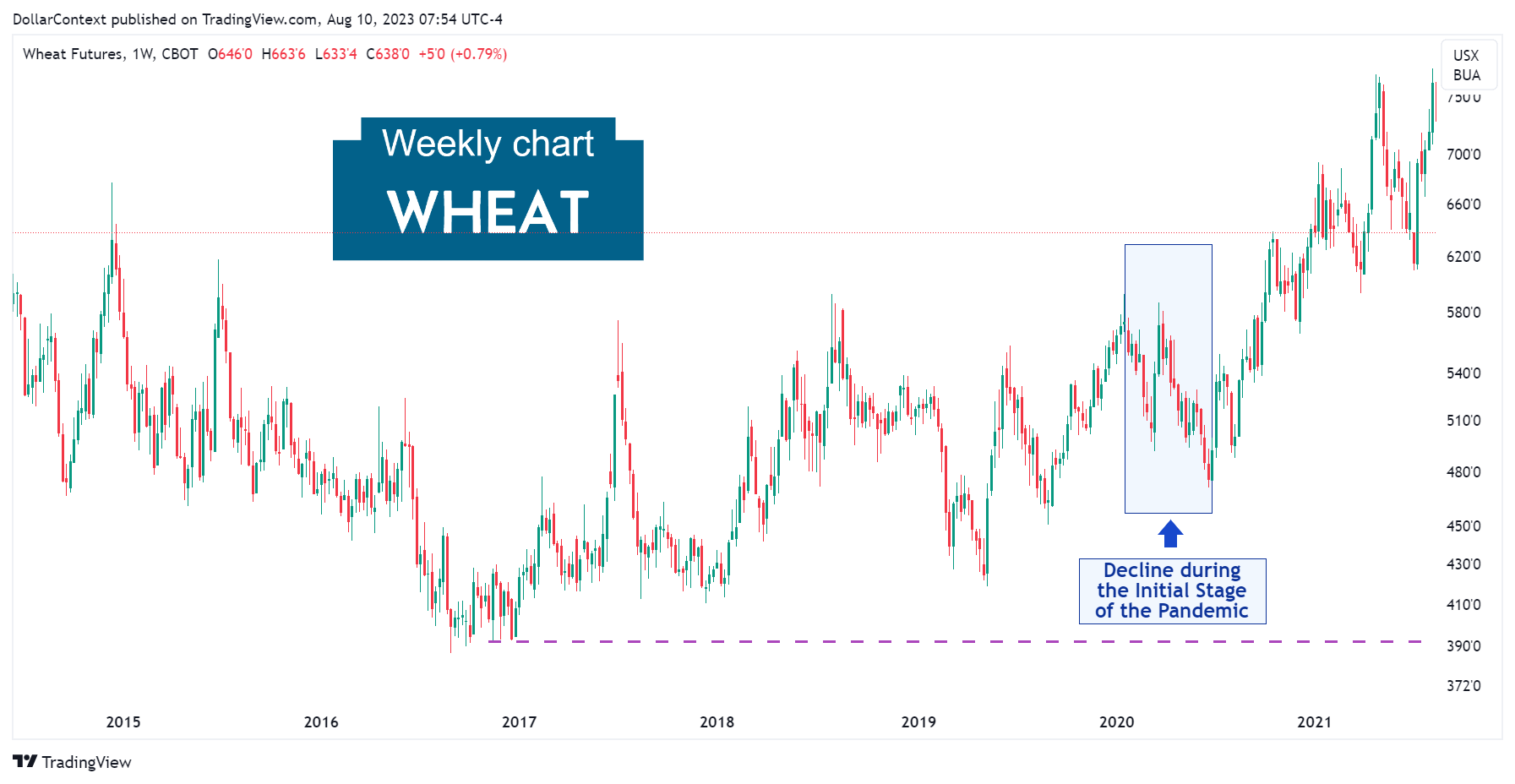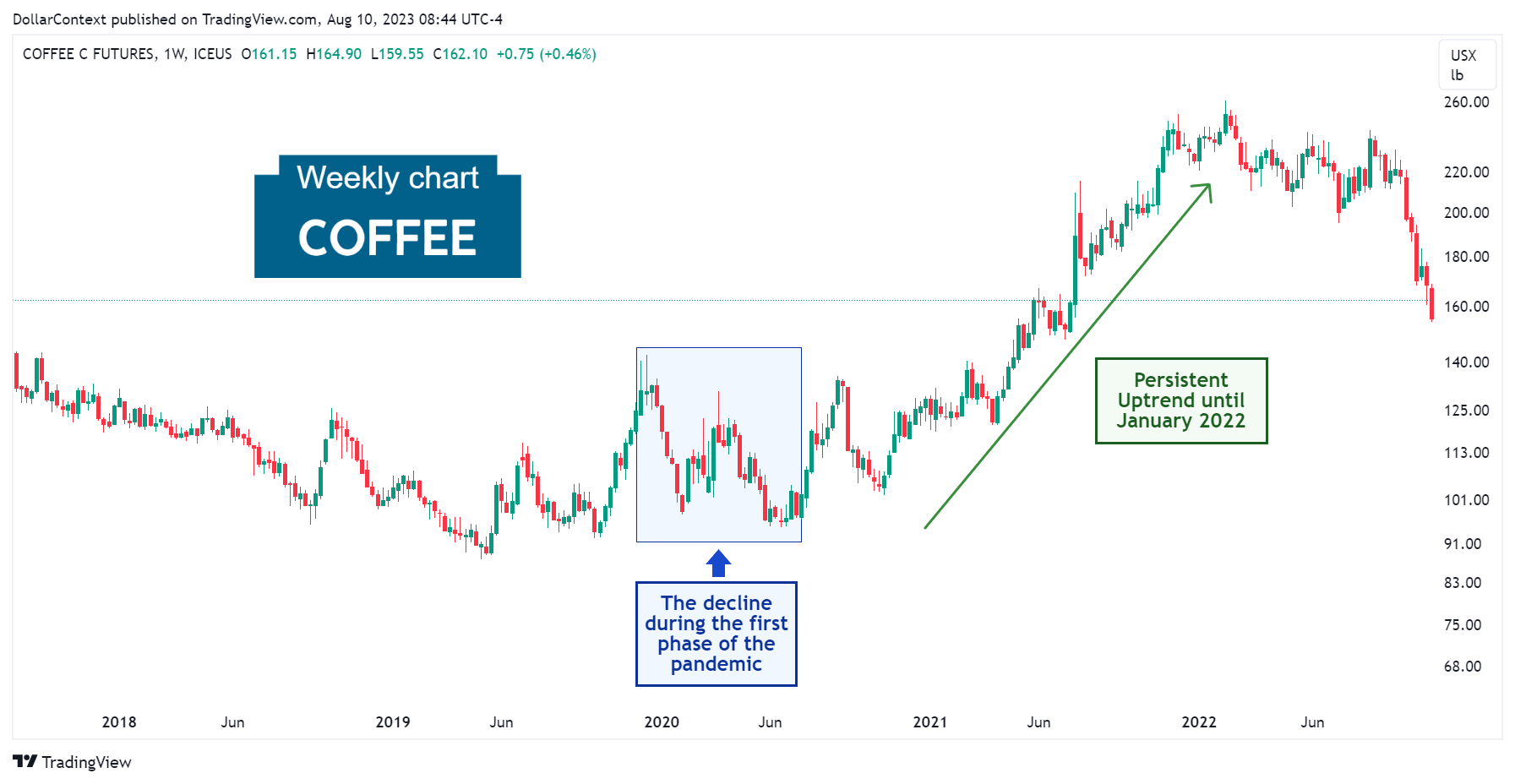Past and Future of Agricultural Commodity Prices
We discuss the technical aspects of a range of agricultural commodity assets and offer our insights on the potential future direction of this market.

In this article, we’re going to discuss the technical aspects of a range of agricultural commodity assets, including wheat, soybeans, corn, cotton, cocoa, coffee, oats, sugar, and rice. To conclude, we'll offer our insights on the potential future direction of this market for the second half of 2023 and into 2024.
1. The Decline During the Pandemic
In the early phases of the pandemic, soft commodities presented a mixed picture. Initially, the majority of these markets witnessed a significant drop, influenced mainly by these global factors:
- Global Economic Slump: The unparalleled health crisis prompted nations to enforce lockdowns and curbs, leading to a global economic slowdown. This, in turn, diminished the overall demand for commodities.
- Rise of the Dollar: During this period, a surge towards safer assets coupled with the dollar's appreciation contributed to increases in worldwide commodity prices, given that these assets are priced in U.S. currency.
Within this framework, and using the lows before the pandemic as a benchmark, agricultural commodities can be categorized into two primary groups:
- Those that dropped to new lows, like corn, cotton, and sugar.
- Those that didn't reach new lows, such as wheat, soybeans, cocoa, coffee, oats, and rice.
For most of these agricultural commodities, however, the downturn during the pandemic wasn't as steep as it was for most non-agricultural commodities.
Observe how corn prices hit a notable new low before initiating an uptrend in April 2020.

By contrast, the wheat market largely remained within its prior broad trading range for the majority of 2020.

2. The Strong Uptrend in Soft Commodities
The global commodity market, including the majority of agricultural commodities, experienced a consistent and robust price uptrend roughly from mid-2020 to the first half of 2022. Several factors contributed to this bullish trend:
- Supply Chain Disruptions: The COVID-19 pandemic significantly upset global supply chains, leading to increased prices.
- Government Stimulus Initiatives: To counteract the economic repercussions of the pandemic, numerous governments rolled out significant stimulus measures. These efforts heightened purchasing capability and drove up demand for soft commodities.
- Global Economic Recovery: As nations worldwide started rebounding from the initial impact of the pandemic, the demand for goods, services, and agricultural commodities saw a resurgence.
Observe the remarkable surge in coffee prices from June 2020 to January 2022 in the chart provided below.

3. The Correction
Since approximately the first half of 2022, a confluence of factors has led to a correction in the majority of agricultural commodity assets. These include:
- Aggressive rate increases by major central banks.
- Strengthening of the dollar throughout 2022 and into the first half of 2023.
- Progressive normalization of commodity supply chains.
At the time of writing, we can say that the predominant form of correction observed in agricultural commodities has been a direct downtrend extending beyond a year. Examples of this are wheat, coffee, oats, and cotton, with oats experiencing one of the most significant corrections, as shown in the chart below.

Soybeans, rice, and corn exhibited a more intricate correction, essentially manifesting in a two-phase decline.

More exceptionally, soft commodities like cocoa and sugar either saw no substantial corrections or very shallow ones.

4. Outlook for the Rest of 2023 and 2024
We believe that two primary factors may influence the trajectory of agricultural prices in 2023 and 2024:
- Supercycle Theory: Since 2020, the commodity market might be experiencing a supercycle period. Typically spanning over eight years, a commodity supercycle leads to significant price hikes across global commodity assets. If this supercycle is indeed in play, it would suggest that the agricultural commodity market has experienced an extended correction through 2022 and the first half of 2023, with potential for a resurgence in the upward trend.
- Recession Concern: The aggressive interest rate hike cycle enacted by the Federal Reserve, combined with a close examination of key leading indicators like the yield curve, indicates a high likelihood of an impending economic slowdown, possibly around 2024. Historically, economic downturns tend to depress commodity prices.
It's crucial to note that these two scenarios can coexist. An economic downturn can either follow or precede a marked increase in commodity prices within the context of a commodity supercycle.





